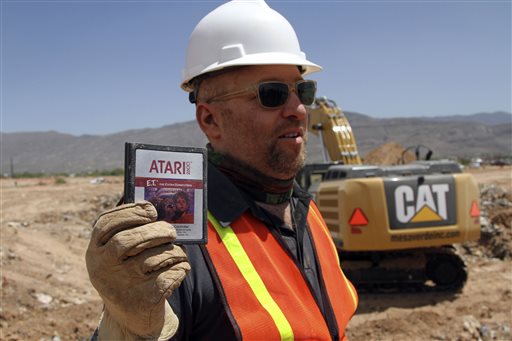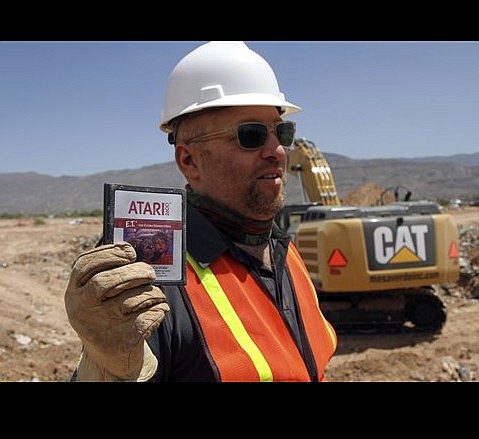 Film Director Zak Penn shows a box of a decades-old Atari 'E.T. the Extra-Terrestrial' game found Saturday in a dumpsite in Alamogordo, N.M. Producers of a documentary dug in a southeastern New Mexico landfill in search of millions of cartridges of the game that has been called the worst game in the history of video gaming and were buried there in 1983.
Film Director Zak Penn shows a box of a decades-old Atari 'E.T. the Extra-Terrestrial' game found Saturday in a dumpsite in Alamogordo, N.M. Producers of a documentary dug in a southeastern New Mexico landfill in search of millions of cartridges of the game that has been called the worst game in the history of video gaming and were buried there in 1983.ALAMOGORDO, N.M. - A decades-old urban legend was put to rest Saturday when workers for a documentary film production company recovered "E.T." Atari game cartridges from a heap of garbage buried deep in the New Mexico desert.
The "Atari grave" was, until that moment, a highly debated tale among gaming enthusiasts and other self-described geeks for 30 years. The story claimed that in its death throes, the video game company sent about a dozen truckloads of cartridges of what many call the worst video game ever to be forever hidden in a concrete-covered landfill in southeastern New Mexico.
The search for the cartridges of a game that contributed to the demise of Atari will be featured in an upcoming documentary about the biggest video game company of the early '80s.
As a backhoe scattered a huge scoop of 30-year-old trash and dirt over the sand, the film crew spotted boxes and booklets carrying the Atari logo. Soon after, a game cartridge turned up, then another and another.
Film director Zak Penn showed assembled gaming fans one cartridge retrieved from the site and said that hundreds more were in the surrounding mounds of garbage.
About 200 residents and game enthusiasts gathered early Saturday at the old landfill in Alamogordo to watch crews search for up to a million discarded copies of "E.T. The Extraterrestrial" that the game's maker wanted to hide forever.
"I feel pretty relieved and psyched that they actually got to see something," Penn said as members of the production team sifted through the mounds of trash, pulling out boxes, games and other Atari products.
Most of the crowd left the landfill before the discovery, turned away by strong winds that kicked up massive clouds of dust mingled with garbage.
By the time the games were found, only a few dozen people remained. Some were playing the infamous game in a makeshift gaming den with a TV and an 1980s game console in the back of a van, while others took selfies beside a life-size E.T. doll inside a DeLorean car like the one that was turned into a time machine in the "Back To The Future" movies.
Among the watchers was Armando Ortega, a city official who as a teenager back in 1983 got a tip from a landfill employee about the massive dump of games.
"It was pitch dark here that night, but we came with our flashlights and found dozens of games," he said. They braved the darkness, coyotes and snakes of the desert landfill and had to sneak past the security guard. But it paid off as they found dozens of crushed but still playable cartridges.
The game's finding came as no surprise to James Heller, a former Atari manager who was invited by the production to the dig site. He says in 1983 the company tasked him with finding an inexpensive way to dispose of 728,000 cartridges they had in a warehouse in El Paso, Texas. After a few local kids ran into trouble for scavenging and the media started calling him about it, he decided to pour a layer of concrete over the games.
"I never heard about again it until June 2013, when I read an article about E.T. being excavated," he remembers. He was not aware of the controversy and never spoke out "because nobody asked."
The documentary about the search is being developed by companies including Xbox Entertainment Studios, and the film is expected to be released later this year on Microsoft's Xbox game consoles.
The city of Alamogordo agreed to give the documentarians up to 250 cartridges and plan to sell the rest that are unearthed.
Mayor Susie Galea hopes this brings more tourists to this southeastern New Mexico town that is home to an Air Force base and White Sands National Monument.
"Lots of people just pass through, unfortunately," she said.
The "E.T." game is among the factors blamed for the decline of Atari and the collapse in the U.S. of a multi-million-dollar video game industry that didn't bounce back for several years.
With the whether-or-not E.T. was buried in Alamogordo controversy solved, the other, subtler debate remains. Was it the worst game ever unleashed on gamers?
Tina Amini, deputy editor at gaming website Kotaku, says the game tanked because "it was practically broken" with that the E.T. falling into traps that were almost impossible to escape and would appear constantly and unpredictably.
The game designer, Howard Scott Warshaw, says he does not mind his creation being called that. "It may be a horrible game, but 32 years after, you are here, talking to me about it. It's a tremendous honor," that it still generates public discourse.
He, however, manages to stress that the company took too long to secure the rights for the game and with Christmas production schedules pressing he was left with just five weeks to design, write and test "the worst game ever."
